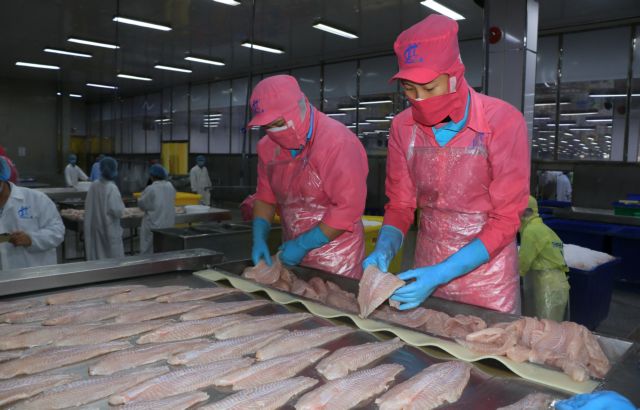 Economy
Economy


|
| Workers process fish fillets for export in a factory in Đồng Tháp Province. VNA/VNS Photo Nhựt An |
HÀ NỘI — Many companies have been so geared to foreign markets that they find it difficult to find favour at home when the global downturn strikes.
The global weakening demand has been wreaking havoc on Vietnamese trade. In the first five months of 2023, the country's total imports and exports hit US$262 billion, down nearly 15 per cent year-by-year.
Scores of companies have begun to fall back on home markets to offset the fall in sales, but 'going back home' turned out not as easy as they thought.
Lê Việt Nga, Deputy Director-General of the Domestic Markets Department, Ministry of Industry and Trade (MOIT), said many companies had been so export-oriented that they have no clue about how to gain a foothold back home.
She took a five-star OCOP producer as an example. The producer could export noodles to the Czech Republic with ease but was struggling to bring the product to a Saigon Coop shopping mall in Hải Phòng City.
Her department had to act as an intermediary between large distributors and OCOP producers to help the latter make their way into domestic supermarkets. Thanks to the effort, some had managed to gain a presence in Saigon Coop, Aeon, and Mega Market.
Lê Hằng, Communication Director of the Vietnam Association of Seafood Exporters and Producers (VASEP), said domestic markets have a vast untapped potential for seafood producers.
However, gaining ground at home has never been an easy feat as most retail chains in Việt Nam are owned by foreign heavyweights. Those foreign players raise commissions once in a while, fueling the situation.
Seafood companies had to look beyond retail chains to gain market shares at home. For instance, around 30 companies in VASEP banded together to form a club of home-targeted producers. They managed to raise their domestic sales to around 50 per cent of their total sales.
The director also remarked that domestic consumers always have an appetite for value-added seafood, especially those in the Northern Region. Frozen seafood, meanwhile, had never caught on among them.
The preference suggests that seafood producers should tailor their products to suit the tastes of each market rather than offer one-size-fits-all solutions at home and abroad.
"Seafood producers clustering around the Southern and Central Regions have to do their homework before entering the Northern Region because consumers there have very different tastes," Hằng said.
Economist Võ Trí Thành said the domestic market has risen to prominence in recent years thanks to a population of close to 100 million and a growing middle class.
He cited a lack of information as the major cause of Vietnamese producers' weak position in their home field.
"Foreign producers always do intensive market research before entering the Vietnamese market. Domestic producers, in contrast, don't bother to do so because they think they know the market inside out," Thành said.
The economist called for measures to bring the producers up to speed, bridging the information gap between them and foreign players.
The Domestic Markets Department said it was sparing no effort in cementing the ties between large distributors and domestic companies. It aimed to raise the coverage of certain seafood products in retail chains from 15 per cent to 40 per cent by 2025. —VNS




